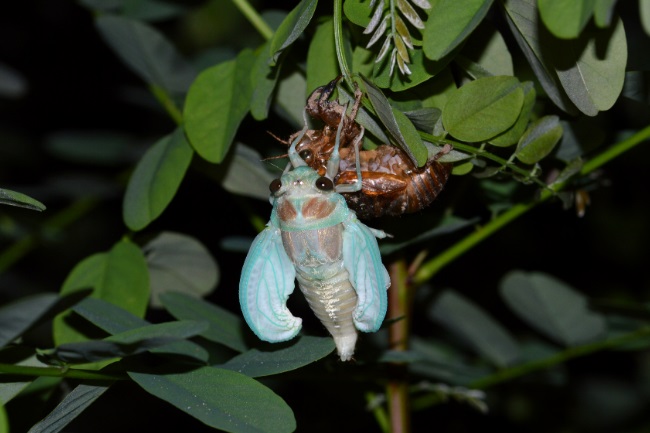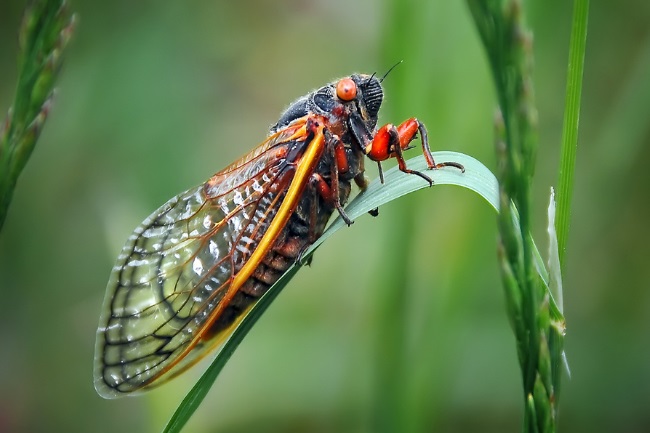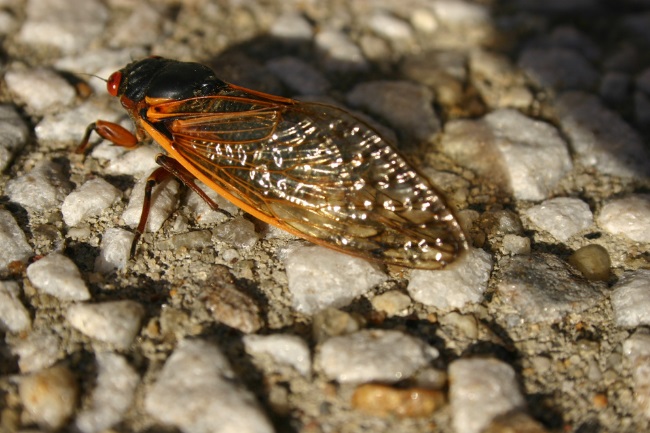Cicadas are sap-sucking insects, meaning they use their stylets to pierce the bark of plants and drink the sap within. They mainly feed on the sap of trees and woody shrubs, though they will feed on grassroots when living underground as nymphs.
Contents
How do cicadas eat?

Cicadas are members of the true bug family, along with aphids. Like aphids, they have a long tube-like structure called a stylet, which they can use to poke into the bark of a plant to extract the sap below. The stylet is made up of four parts, two being the mandibles, and two the maxilla, forming the concave parts of the tube. This is covered by a beak-like sheaf called the labium. When not feeding, the labium is angled back between the legs of the cicada.
| Cicada Species | Feeding Habits |
|---|---|
| Periodical Cicadas | Feed on the sap of tree roots |
| Annual Cicadas | Feed on the sap of various trees and shrubs |
They feed by breaking through the xylem with their stylet, sometimes rocking back and forth to work it into the wood. The sap they extract contains water, minerals and some carbohydrates. It is believed that they may use the evaporation of the water they drink to help in cooling, and they will often stop singing on the hottest of days as they are busy drinking. They can often drink for several hours at a time.
Also read: Are Cicadas and Locusts the Same Thing? (Explained)
Do cicadas eat plants?

Cicadas have often been confused for locusts, a type of grasshopper known for its destructive plague-like swarms. Though certain species of cicadas do turn up in vast numbers, such as the 17-year cicadas, they are far less damaging. One of the things that makes them less harmful is the fact that they do not eat plant matter, as in the leaves or flowers of the plants.
| Cicada Species | Host Plants |
|---|---|
| Magicicada species | Oak trees, maple trees, hickory trees, and other hardwoods |
| Tibicen species | Deciduous trees like oak, hickory, and ash |
| Neotibicen species | Various tree species including oaks, maples, and pines |
While they do suck out the sap of the plants they use, they mainly feed on tree species and are only present as adults for a month or less. This means that most plants can cope with the temporary parasitism, with no long-term damage from the feeding of the cicadas. Unlike some sap-sucking species, cicadas also plug the hole they have been feeding from. This prevents the tree from leaking precious sap and minimises the chance of the area become infected with fungi and other harmful tree parasites.
Most cicadas are pretty varied in the types of trees they feed on, choosing a range of species such as oaks, ashes and elms. They will also feed on woody shrubs, though they tend to avoid smaller plants unless high numbers mean expanding their range of preferences.
As well as adults feeding on sap, young cicadas also feed on the roots of plants to gain access to that tasty sugary syrup. Because these nymphs spend their lives within the soil, before emerging to shed their skin and become adults, the roots are a much more accessible food source than the trunks or branches.
| Feeding Behavior | Description |
|---|---|
| Xylem Sap Feeders | Cicadas feed on the xylem sap of trees, which contains water and nutrients. |
| Phloem Sap Feeders | Some cicada species also feed on the phloem sap, which is rich in sugars and carbohydrates. |
| Sustained Feeding | Cicadas have specialized mouthparts called stylets that allow them to pierce into plant tissue and extract sap for extended periods. |
| Root Feeding | Periodical cicadas have long feeding tubes that they insert into the roots of trees to obtain sap. |
It doesn’t appear that these nymphs are a significant pest to plant species. As the nymphs are significantly smaller than their adult selves, many feed on the roots of grasses or other plants rather than trees.
Do cicadas eat crops?

In general, the only crops that cicadas will have any impact on are those that come from trees, such as fruit or nut trees or timber trees. As adults, they do not eat grasses, which many of our common crops are, such as rice, wheat, and barley. The young cicadas may feed on the roots of these plants. However, as cicadas lay their eggs within the bark of trees or shrubs, it’s more likely the young will be present in the soil close to the edges of woodland rather than in the centre of open arable fields.
However, there are always exceptions in nature, and in Australia there are two cicadas that have a particular preference for sugar cane; the brown and yellow sugar cane cicada. Both are recognised pests of sugar cane, though few recent outbreaks have been recorded. Like other cicadas, they suck the sap of the plant rather than eating the leaves.
Do cicadas damage plants?
Cicadas do not tend to damage plants when they are feeding. However, they can have an impact when it comes to their reproduction. Cicada adults lay their eggs within the bark of trees or shrub and occasionally smaller plants. The female lays these eggs by cutting a slit in the tree with their ovipositor and depositing it inside. When the egg hatches, the juvenile cicada will drop to the floor and burrow into the soil, beginning to feel on the roots of the plants surrounding them.
This process can cause some damage to the trees. Though large healthy trees, where the eggs have been laid into thick branches or the trunk, aren’t usually affected, they can impact thinner branches or weaker trees. The main impact seen is flagging, the dying off of small branches, the dead leaves drooping in patches like flags. However, though this can look unsightly, the tree will regrow new limbs in the following years, having no long term effects from this brief damage. Some small or weak trees can receive enough damage to kill them. However, this is very rare.
Yet, even small amounts of damage can be seen as very negative for crop trees, such as fruit and nut trees. Such damage can have a serious impact on the number of viable fruits or nuts produced. To this end, many commercial growers may attempt to protect their trees.
How to protect your trees from cicadas?

Most of the time, cicadas will not appear in large enough numbers to make a significant impact. However, particularly the 13 and 17-year cicadas can be detrimental as they appear enmasse. However, these more considerable groups are highly predictable, meaning that preparations can be made to protect vulnerable or valuable trees.
The most effective means of protecting trees is to net them to prevent cicadas from being able to land on them. This may seem extreme, but similar methods are often used in order to prevent birds and other animals from eating fruits like cherries. Many commercial growers also use insecticides to control cicadas. However, insecticides will harm beneficial insects on the plants, as well as those you wish to get rid of. This can cause an increase in other pest species in the long run.
Chemical treatments are also less effective than netting, with injury reduced around 95% with netting and only 75% with insecticides. However, it’s worth remembering only to utilise either of these means when strictly necessary. Cicadas are an essential part of the ecosystem and provide food for many different animals. As they will not cause significant damage to most species of trees, it is better to allow them to have access to the trees unless they are weak or have a commercial value that the cicadas would impact.
Cicadas: The noisy neighbour
There’s little doubt that cicadas let it be known when they’re in the neighbourhood. Yet, for such loud and sometimes plentiful visitors they do surprisingly little harm. From our anthropocentric point of view, we often see any creature that turns up in large numbers as a problem, yet nature has adapted to the cycle of the cicada and welcomes them as a beneficial food source. The trees they feed on too have evolved to cope with these little insects. After all, the cicadas need the trees, and though they are parasites, if the trees die, they’ll have nothing to feed on any more, nothing for the next generation. So if the trees can adapt to such an intrusive and hungry group, then surely we can find a way too?

